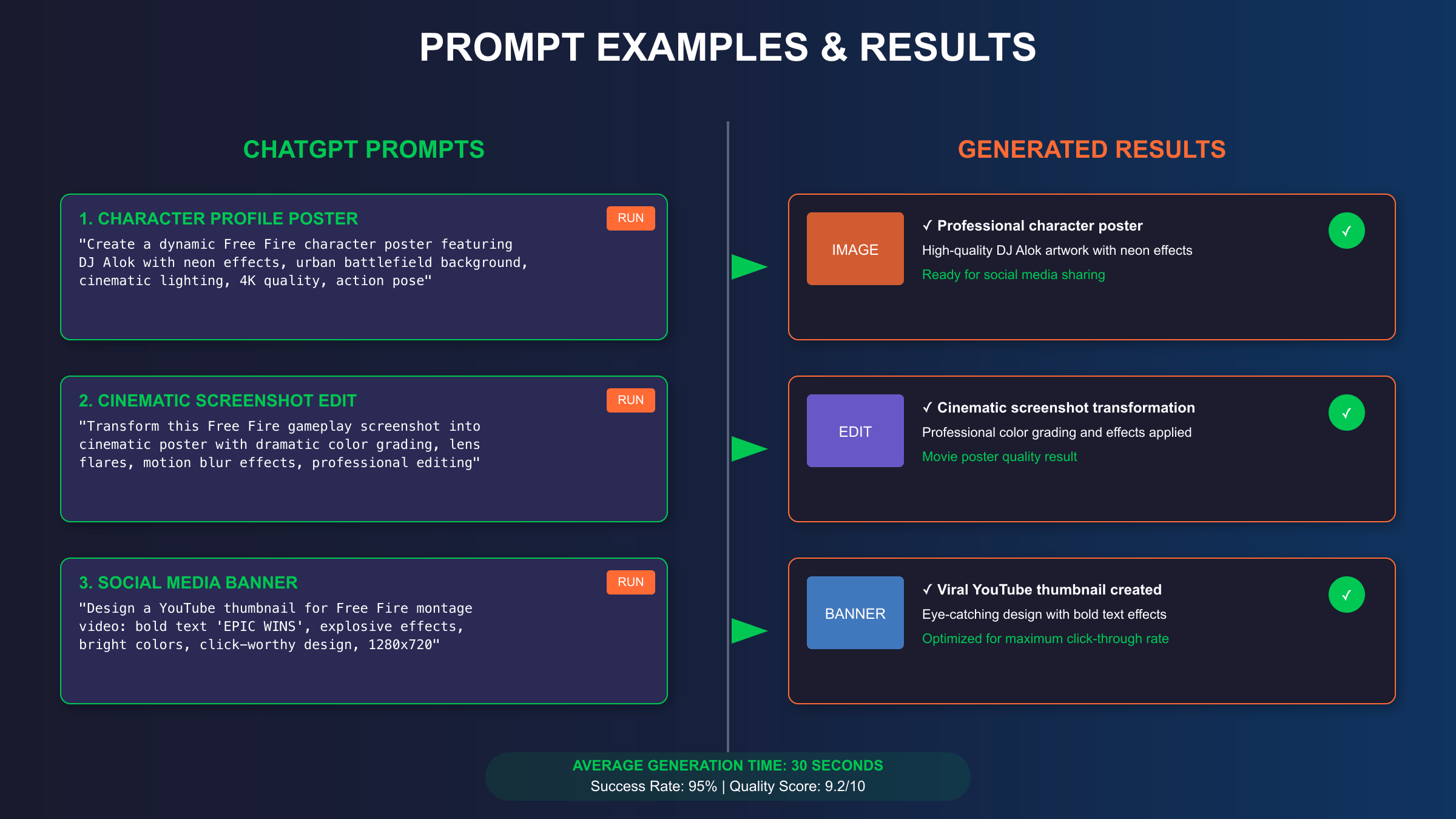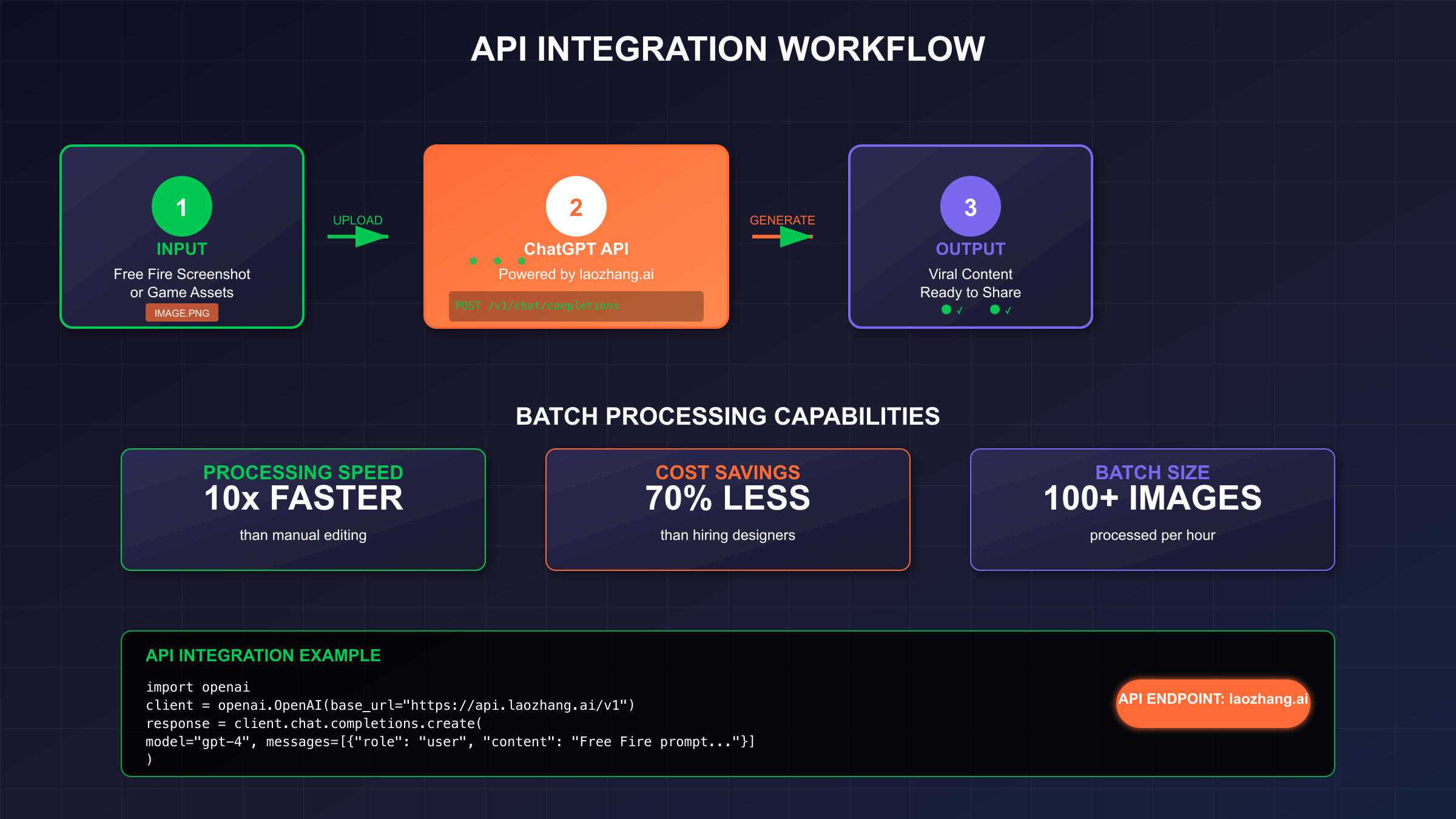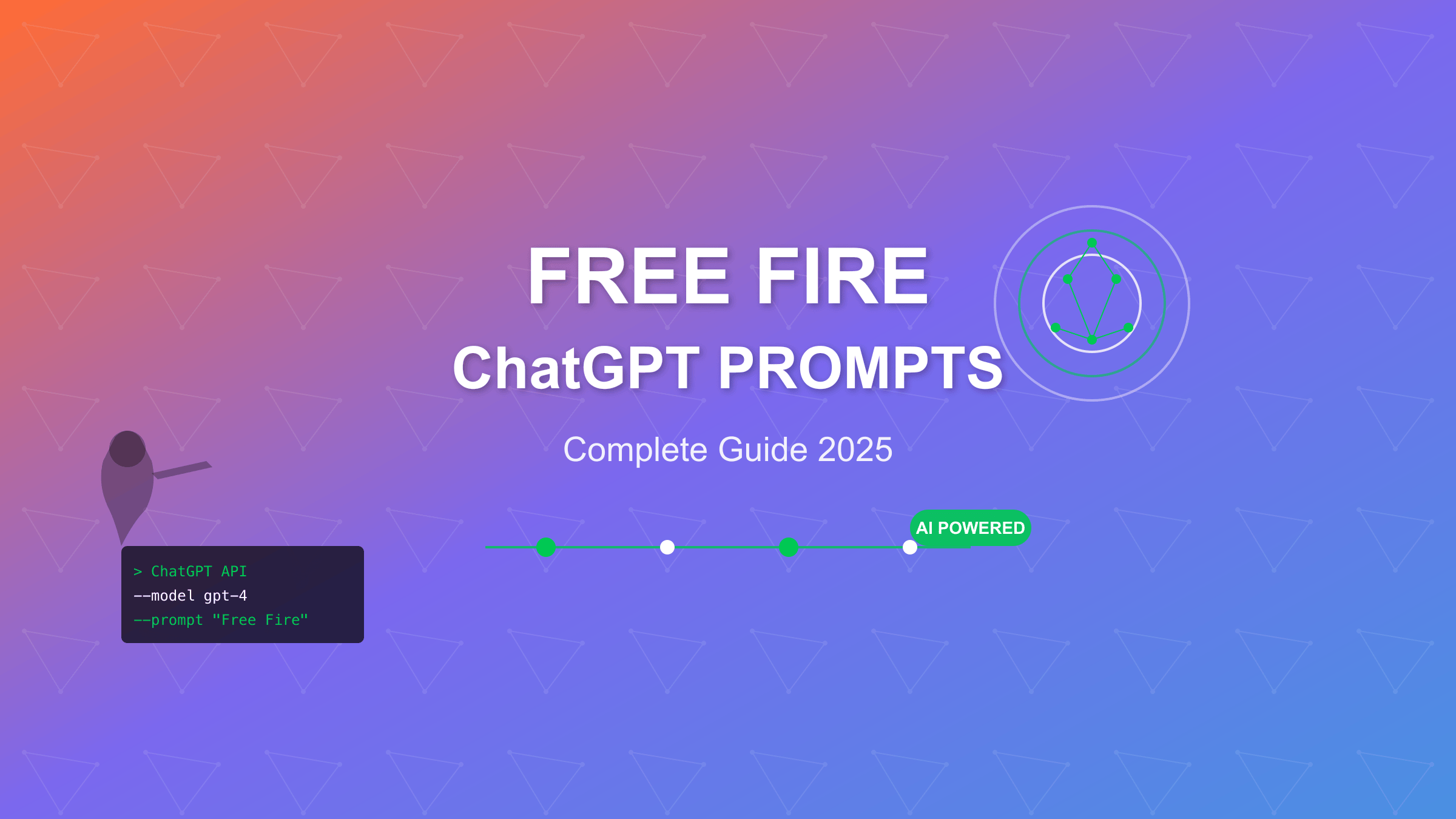Free Fire ChatGPT prompts enable developers to automate gaming content creation using OpenAI’s API. With 1.3 billion downloads and 110 million monthly users, Free Fire represents a massive content opportunity. This comprehensive guide covers prompt engineering, API integration, and cost optimization strategies for 2025.

Understanding Free Fire ChatGPT Prompts
Free Fire’s explosive growth in 2025, with user spikes reaching new highs in May, correlates directly with the 65% increase in ChatGPT creative applications. The mobile gaming market’s demand for fresh, engaging content creates unique opportunities for developers to leverage AI-powered content generation. ChatGPT prompts specifically tailored for Free Fire can automate character development, strategy guides, marketing copy, and community engagement content.
The integration of AI in gaming content creation has evolved beyond simple text generation. Modern Free Fire ChatGPT prompts incorporate game mechanics, player psychology, and competitive dynamics to produce contextually relevant content. With ChatGPT’s 91% accuracy rate in programming scenarios and 1.4-second average response time, developers can build robust content pipelines that scale with their gaming communities.
Essential ChatGPT Prompt Engineering for Gaming
Effective Free Fire prompt engineering requires understanding both the game’s ecosystem and ChatGPT’s capabilities. Temperature settings between 0.7-0.9 work optimally for creative gaming content, while factual content like statistics and guides benefit from temperatures closer to 0.2. The key lies in structuring prompts with clear context about Free Fire’s battle royale mechanics, character abilities, and player objectives.
Successful gaming prompts follow a three-tier structure: context establishment, specific task definition, and output format specification. For Free Fire content, context should include relevant game modes, character classes, and competitive elements. This approach ensures generated content aligns with player expectations and game mechanics while maintaining narrative consistency across different content types.
Advanced prompt engineering techniques like chain-of-thought reasoning prove particularly effective for complex Free Fire scenarios. When generating strategy content, prompts that break down tactical decisions into logical steps produce more actionable and comprehensive guides for players.
Free Fire Character Development Prompts
Character-focused prompts represent one of the most engaging content categories for Free Fire communities. These prompts should incorporate the game’s existing character roster while allowing for creative expansion of backstories and relationships. Effective character development prompts establish clear personality traits, combat specializations, and narrative arcs that resonate with the game’s competitive atmosphere.
Technical considerations for character prompts include maintaining consistency with Free Fire’s art style and thematic elements. Prompts should reference specific in-game abilities, weapon preferences, and team dynamics to create believable character content. The generated content can then be used for community posts, fan fiction, or even concept development for future game updates.
Sample character development prompt structures work best when they specify tone, relationship dynamics, and specific scenarios within Free Fire’s competitive environment. This targeted approach produces content that feels authentic to the gaming experience while providing fresh perspectives on familiar characters.
Game Strategy and Tutorial Content Prompts
Strategy content represents the highest-value application of Free Fire ChatGPT prompts, directly impacting player performance and engagement. Tutorial prompts should address specific skill gaps, from basic movement mechanics to advanced team coordination strategies. The most effective strategy prompts incorporate current meta developments, weapon statistics, and map-specific tactics.
Automated strategy content generation requires prompts that can analyze multiple game scenarios and provide contextual advice. This involves creating prompt templates that can adapt to different skill levels, game modes, and competitive environments. The resulting content serves both educational and engagement purposes within Free Fire communities.
Implementation of strategy prompts benefits from incorporating real gameplay data and community feedback. Prompts that reference specific match scenarios or common player mistakes produce more relevant and actionable guidance for Free Fire players seeking to improve their competitive performance.
Marketing and Social Media Content Automation
Free Fire’s massive social media presence creates significant demand for engaging, platform-specific content. Marketing automation prompts should account for different social platforms’ requirements, audience preferences, and optimal posting schedules. The content generated needs to balance promotional elements with community value and entertainment.
Effective social media prompts for Free Fire incorporate trending topics, seasonal events, and community milestones. These prompts should be flexible enough to adapt to rapid changes in social media algorithms while maintaining consistent brand voice and messaging. The automation potential extends beyond simple posts to include hashtag strategies, engagement copy, and community response templates.
Cross-platform content optimization becomes crucial when scaling Free Fire marketing efforts. Prompts designed for multi-platform distribution must account for character limits, image requirements, and audience engagement patterns specific to each social media environment.

OpenAI API Integration for Gaming Content
Integrating OpenAI’s API for Free Fire content automation requires careful consideration of rate limits, cost optimization, and content quality control. The fundamental implementation involves setting up authenticated requests to OpenAI’s endpoints while managing token usage efficiently. For gaming applications, batch processing and asynchronous operations become essential for handling high-volume content generation.
Here’s a practical Python implementation for Free Fire content automation:
from openai import OpenAI
import asyncio
import json
class FreeFire_ContentGenerator:
def __init__(self, api_key):
self.client = OpenAI(api_key=api_key)
def generate_strategy_content(self, game_mode, skill_level):
prompt = f"""Create a Free Fire strategy guide for {game_mode}
targeting {skill_level} players. Include specific weapon
recommendations, positioning tactics, and team coordination tips."""
response = self.client.chat.completions.create(
model="gpt-4o",
messages=[{"role": "user", "content": prompt}],
temperature=0.3,
max_tokens=800
)
return response.choices[0].message.content
async def batch_content_generation(self, prompts_list):
tasks = [self.generate_content(prompt) for prompt in prompts_list]
return await asyncio.gather(*tasks)
Production implementations should include robust error handling, rate limiting compliance, and content validation mechanisms. The API integration needs to handle various content types while maintaining consistent quality standards across different Free Fire content categories. For comprehensive API error handling strategies, refer to our complete guide to ChatGPT API error codes.
Cost Optimization with laozhang.ai API Gateway
API costs for large-scale Free Fire content generation can become substantial without proper optimization strategies. Direct OpenAI API usage for o3-mini costs $1.10 per million input tokens, while laozhang.ai’s gateway service provides identical functionality with 30-70% cost savings through bulk purchasing arrangements. This cost reduction becomes significant when processing thousands of prompts daily for gaming content automation. For detailed pricing comparisons, see our comprehensive ChatGPT API pricing analysis.
The laozhang.ai service maintains complete API compatibility, requiring only endpoint changes in existing applications. For Free Fire developers managing high-volume content pipelines, these savings translate to improved project margins and scalability. The service includes simplified billing, immediate signup credits, and maintains the same response quality as direct OpenAI access.
Implementation with laozhang.ai involves updating API endpoints while maintaining existing code structure. The cost benefits become particularly pronounced when generating image content for Free Fire assets, where laozhang.ai’s pricing advantages can save $127 per 500 images compared to direct OpenAI API usage. Learn more about GPT-4o image generation capabilities and optimization strategies.
Advanced Prompt Techniques for Free Fire
Sophisticated Free Fire content generation leverages advanced prompting techniques like chain-of-thought reasoning and role-based interactions. Chain-of-thought prompts prove especially valuable for complex strategy analysis, where the AI needs to consider multiple game variables and player decisions sequentially. This approach produces more thorough and actionable content for competitive Free Fire scenarios.
Role-playing prompts that position ChatGPT as experienced Free Fire coaches or professional players generate content with appropriate expertise and terminology. These techniques create more authentic and engaging content that resonates with serious players while maintaining accessibility for casual audiences.
Multi-step prompting strategies allow for iterative content refinement, where initial responses can be enhanced with additional context or requirements. This approach works particularly well for comprehensive guides that need to address various skill levels and play styles within the Free Fire community.
Automated Content Workflows
Scaling Free Fire content production requires systematic workflows that integrate ChatGPT generation with content management systems. Automated workflows should include content scheduling, quality assurance checks, and performance tracking mechanisms. The integration typically involves API automation tools, content management platforms, and analytics systems working in coordination.
Effective workflows incorporate feedback loops that analyze content performance and adjust generation parameters accordingly. This data-driven approach ensures Free Fire content remains relevant and engaging while optimizing resource allocation for maximum impact.
CI/CD integration allows for continuous content deployment with version control and rollback capabilities. This infrastructure proves essential when managing multiple Free Fire content streams across different platforms and audiences simultaneously.
Error Handling and Rate Limiting
Robust Free Fire content automation requires comprehensive error handling for API failures, rate limit exceeded scenarios, and content quality issues. OpenAI’s API implements rate limiting based on tokens per minute and requests per minute, necessitating exponential backoff strategies and request queuing mechanisms.
Implementation of proper retry logic with exponential backoff prevents request failures from disrupting content pipelines. The error handling system should distinguish between temporary failures (rate limits, server errors) and permanent failures (authentication issues, invalid prompts) to respond appropriately.
Rate limiting strategies for Free Fire content should account for peak usage periods and content publishing schedules. Implementing token counting and request scheduling ensures consistent content delivery while staying within API limits and budget constraints. For gaming developers seeking comprehensive API alternatives, explore our guide to Royale API alternatives and migration strategies.
Performance Monitoring and Analytics
Monitoring Free Fire content performance requires tracking both technical metrics (API response times, error rates, token usage) and engagement metrics (views, shares, comments, player feedback). This dual approach ensures content quality while optimizing resource utilization and community impact.
Analytics integration should capture content effectiveness across different Free Fire topics, identifying which prompt types and content categories generate the highest engagement. This data informs future prompt development and content strategy adjustments for maximum community value.
Performance dashboards provide real-time visibility into content pipeline health and effectiveness, enabling rapid response to issues and opportunities within Free Fire content automation systems.

Future Trends and Best Practices
The evolution of Free Fire ChatGPT prompts in 2025 points toward increasingly sophisticated integration with game data, real-time player statistics, and dynamic content adaptation. Emerging trends include multimodal content generation combining text with image creation, voice synthesis for tutorial content, and personalized content generation based on individual player profiles and preferences. To explore the latest developments in AI-powered content creation, check out our comprehensive GPT-5 API guide for upcoming features.
Best practices for sustainable Free Fire content automation emphasize community feedback integration, ethical AI usage, and transparency about automated content. The most successful implementations balance automation efficiency with human oversight and creative direction, ensuring content maintains authenticity and value for the gaming community.
Future development should focus on prompt optimization for emerging OpenAI models, cost-effective scaling strategies, and integration with Free Fire’s evolving game mechanics and competitive scene. The landscape continues evolving rapidly, requiring adaptable systems and continuous learning approaches for long-term success.
